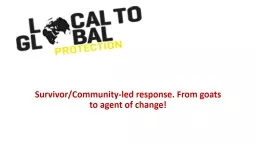

What are the characteristics of communityled responses when external aid is absent ie what are the positive and negative actions of local people during a crisis when there is no external support ID: 807687
Download The PPT/PDF document "Survivor/Community-led response. From go..." is the property of its rightful owner. Permission is granted to download and print the materials on this web site for personal, non-commercial use only, and to display it on your personal computer provided you do not modify the materials and that you retain all copyright notices contained in the materials. By downloading content from our website, you accept the terms of this agreement.
Slide1
Survivor/Community-led response. From goats to agent of change!
Slide2Slide3What are the characteristics of community-led responses when external aid is absent (i.e.
what are the positive and negative actions of local people during a crisis when there is no external support)?People depend more on each other, self-help, local resources, local ideasMultiple community groups want to manage their own multiple, holistic responses...but are limited by lack of resourcesPeople do not separate “humanitarian”, “protection”, “development”, livelihoods etc
Greater focus given to livelihoods and longer term recovery and even root-causes
Importance of social, cultural, dignity and non-material needs (psychosocial)
Efficiacy of many (not all) local knowledge and processes
Knowledge and information are not evenly distributedAnd of course neither is power or capacity...complex exclusion/inclusion issues (gender, ethnicity, social status, age, health)
Slide4What do crisis affected people think of externally-led humanitarian assistance?
First and foremost, appreciation of scale, scope, intention and often critical life-saving nature of assistanceBut, frustration with tendency to be: less responsive (to local needs & opportunities) slow to start
quick to leave
less cost effective
poorly coordinatedat times divisiveInsensitive, degrading
ignoring local ideas, knowledge, capacityOver time can promote learned helplessness, dependencyCan reinforce unhelpful power structures
Slide5Slide6‘ community members are not like goats, they need more than food and water to survive’ LPRR co-design workshop participants (2017)
Slide7LPRR: how can humanitarian response strengthen community resilience? From theory to practice
Slide8Research= literature review!
The KCL literature review identified two gaps in existing research: A lack of knowledge that focuses on ASKING SURVIVORS AND FIRST RESPONDERES
their recommendations
A lack of
systematic implementation and evaluation of practical recommendations Additionally the resilience lenses allow us to put more emphasis on the
community capacities and in particular on the opportunities for transformation created by the disasters
Slide9The LPRR Study’s Aim
To capture the recommendations and perceptions made by local stakeholders (first responders and crises survivors) for how humanitarian response can be strengthened to enable (and not undermine) long term community resilience building.
Slide10The KCL Study
Location
Organisation
Hazard
Philippines, Manila
Christian Aid
Typhoon Ketsana Philippines, Ormoc
HelpAge
Typhoon Haiyan
Kenya, Nairobi
World Vision & Concern Worldwide
Food Insecurity
Indonesia, Banda Aceh
Muslim Aid
Tsunami
Pakistan, Sindh
World Vision
Floods
Colombia, Cacarica
Christian Aid
Conflict & Displacement
Bangladesh, Patuakhali
Action Aid
Cyclone
DRC, South Kivu
Christian Aid
Conflict & Displacement
Slide11Perception of ResilienceThe crises survivors felt that resilience meant both independence and support when needed. “Resilience means having the skills and capacity to look after yourself whilst knowing how and where to ask for support when needed.”(LPRR Local Stakeholders)
Slide12Bigger picture: what is this paper saying?
The learnings from this study speak to both the preparedness and humanitarian response phase of an intervention
It presents the recommendations made by crises survivors and first responders
on what approach should be taken and what activities should be included to harness these opportunities
.
If effectively operationalised, it is argued that this newly informed set of recommendations have the potential to bridge the gap between short term and long term interventions,
align all phases of the disaster cycle and pave the way for transformational community resilience building.
Slide13LPRR 6 principles
Slide14Slide15The LPRR pilots:
Run from September 2017 till end of January 2018Microgrants: 27 HSGs/CBOs/VDCs reaching 1,820 HHsKenya (£30,000x 3 partners – PACIDA, CIFA and MIONET)Myanmar (£30,000 x 4 partners- KBC, DEAR MM, BBS and MRF)
Type of interventions:
55% livelihood recovery/diversification;
25% access to services (water, education); 15% relief (food and cash) 5% (2) peace building
Slide16Survivor/community-led response
https://vimeo.com/312168167
Slide17For more information:
https://www.local2global.info/
Contacts:
Nils Carstensen nic@dca.dk;
Henrik Fröjmark henrik.frojmark@svenskakyrkan.se ;Simone Di Vicenz
SDiVicenz@christian-aid.org